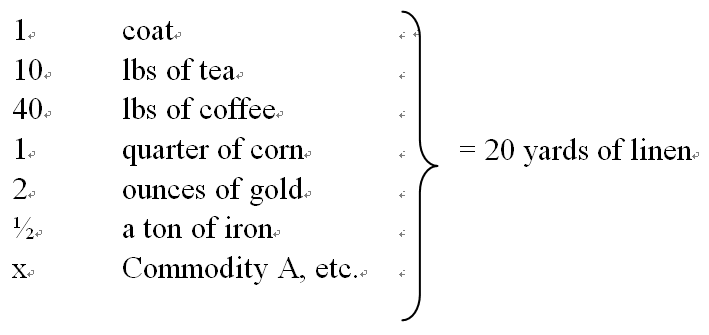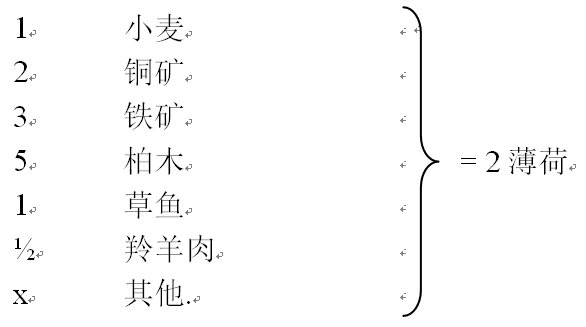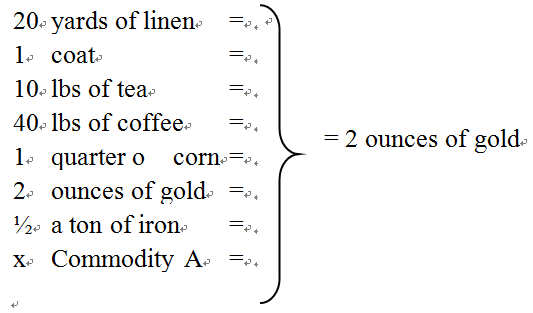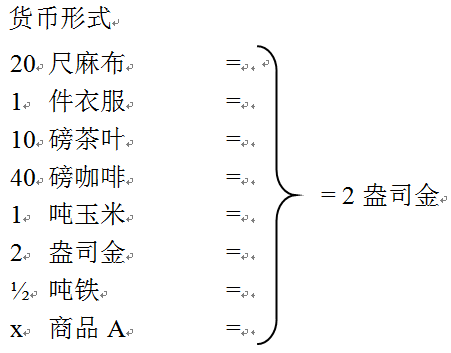006-General-Form-of-Value
C. The General Form of Value

Value的普遍形式

1. The altered character of the form of value
Value形式的变化了的性质
All commodities now express their value (1) in an elementary form, because in a
single commodity; (2) with unity, because in one and the same commodity. This
form of value is elementary and the same for all, therefore general.
各种商品的Value表现形式都是唯一的,也都是统一的,因为它们都用同一种商品(薄荷)作等价物。这个Value形式是基本的、共同的、普遍的。
The forms A and B were fit only to express the value of a commodity as something
distinct from its use value or material form.
Value的基本形式和扩展形式只将商品的Value表现为与商品的使用价值或肉体不同的东西。
The first form, A, furnishes such equations as the following: – 1 coat = 20
yards of linen, 10 lbs of tea = ½ a ton of iron. The value of the coat is
equated to linen, that of the tea to iron. But to be equated to linen, and again
to iron, is to be as different as are linen and iron. This form, it is plain,
occurs practically only in the first beginning, when the products of labour are
converted into commodities by accidental and occasional exchanges.
Value的基本形式,描述的是最初的交换阶段,即人类仅偶尔地交换劳动产品的阶段。此时,劳动产品仅偶尔地成为商品。
The second form, B, distinguishes, in a more adequate manner than the first, the
value of a commodity from its use value, for the value of the coat is there
placed in contrast under all possible shapes with the bodily form of the coat;
it is equated to linen, to iron, to tea, in short, to everything else, only not
to itself, the coat. On the other hand, any general expression of value common
to all is directly excluded; for, in the equation of value of each commodity,
all other commodities now appear only under the form of equivalents. The
expanded form of value comes into actual existence for the first time so soon as
a particular product of labour, such as cattle, is no longer exceptionally, but
habitually, exchanged for various other commodities.
Value的扩展形式,描述的是人类习惯性地用某种劳动产品(例如牲畜)交换其他各种商品的阶段。
The third and lastly developed form expresses the values of the whole world of
commodities in terms of a single commodity set apart for the purpose, namely,
the linen, and thus represents to us their values by means of their equality
with linen. The value of every commodity is now, by being equated to linen, not
only differentiated from its own use value, but from all other use values
generally, and is, by that very fact, expressed as that which is common to all
commodities. By this form, commodities are, for the first time, effectively
brought into relation with one another as values, or made to appear as exchange
values.
Value的普遍形式,使得商品之间首次正式作为Value建立关系,或者说,呈现为交换价值。
The two earlier forms either express the value of each commodity in terms of a
single commodity of a different kind, or in a series of many such commodities.
In both cases, it is, so to say, the special business of each single commodity
to find an expression for its value, and this it does without the help of the
others. These others, with respect to the former, play the passive parts of
equivalents. The general form of value, C, results from the joint action of the
whole world of commodities, and from that alone. A commodity can acquire a
general expression of its value only by all other commodities, simultaneously
with it, expressing their values in the same equivalent; and every new commodity
must follow suit. It thus becomes evident that since the existence of
commodities as values is purely social, this social existence can be expressed
by the totality of their social relations alone, and consequently that the form
of their value must be a socially recognised form.
All commodities being equated to linen now appear not only as qualitatively
equal as values generally, but also as values whose magnitudes are capable of
comparison. By expressing the magnitudes of their values in one and the same
material, the linen, those magnitudes are also compared with each other. For
instance, 10 lbs of tea = 20 yards of linen, and 40 lbs of coffee = 20 yards of
linen. Therefore, 10 lbs of tea = 40 lbs of coffee. In other words, there is
contained in 1 lb of coffee only one-fourth as much substance of value – labour
– as is contained in 1 lb of tea.
The general form of relative value, embracing the whole world of commodities,
converts the single commodity that is excluded from the rest, and made to play
the part of equivalent – here the linen – into the universal equivalent. The
bodily form of the linen is now the form assumed in common by the values of all
commodities; it therefore becomes directly exchangeable with all and every of
them. The substance linen becomes the visible incarnation, the social chrysalis
state of every kind of human labour. Weaving, which is the labour of certain
private individuals producing a particular article, linen, acquires in
consequence a social character, the character of equality with all other kinds
of labour. The innumerable equations of which the general form of value is
composed, equate in turn the labour embodied in the linen to that embodied in
every other commodity, and they thus convert weaving into the general form of
manifestation of undifferentiated human labour. In this manner the labour
realised in the values of commodities is presented not only under its negative
aspect, under which abstraction is made from every concrete form and useful
property of actual work, but its own positive nature is made to reveal itself
expressly. The general value form is the reduction of all kinds of actual labour
to their common character of being human labour generally, of being the
expenditure of human labour power.
The general value form, which represents all products of labour as mere
congelations of undifferentiated human labour, shows by its very structure that
it is the social resumé of the world of commodities. That form consequently
makes it indisputably evident that in the world of commodities the character
possessed by all labour of being human labour constitutes its specific social
character.
Value的普遍形式,将所有劳动产品视为无差别人类劳动的凝结。它是商品世界的社会表现。它清楚地表明,人类劳动具有社会性。
2. The Interdependent Development of the Relative Form of Value, and of the Equivalent Form
Value的相对形式和等价形式的共同发展
The degree of development of the relative form of value corresponds to that of
the equivalent form. But we must bear in mind that the development of the latter
is only the expression and result of the development of the former.
Value的相对形式的发展程度与等价形式的发展程度是相适应的。但我们必须记住,等价形式的发展,是相对形式的发展的表现和结果。
The primary or isolated relative form of value of one commodity converts some
other commodity into an isolated equivalent. The expanded form of relative
value, which is the expression of the value of one commodity in terms of all
other commodities, endows those other commodities with the character of
particular equivalents differing in kind. And lastly, a particular kind of
commodity acquires the character of universal equivalent, because all other
commodities make it the material in which they uniformly express their value.
【人类历史上的商品世界的发展过程是这样的:】最初,Value的基本形式中的左侧商品将另一种商品视为等价物。然后,扩展了的相对形式,赋予了其他各种商品等价形式。最后,一种特别的商品获得了一般等价物的角色,其他商品都以它为表达Value的材料。
The antagonism between the relative form of value and the equivalent form, the
two poles of the value form, is developed concurrently with that form itself.
Value的相对形式和等价形式的对立,Value形式的这阴阳两极,随着Value形式的发展而同步发展。
The first form, 20 yds of linen = one coat, already contains this antagonism,
without as yet fixing it. According as we read this equation forwards or
backwards, the parts played by the linen and the coat are different. In the one
case the relative value of the linen is expressed in the coat, in the other case
the relative value of the coat is expressed in the linen. In this first form of
value, therefore, it is difficult to grasp the polar contrast.
“2薄荷=1小麦”这个基本形式,就已经包含着这种对立,且没有使之固定。在FarmerA看来,2薄荷是相对形式,1小麦是等价形式;在交易对方看来,1小麦是相对形式,2薄荷是等价形式。在这个基本形式中,还难以掌握阴阳两极的对立。
Form B shows that only one single commodity at a time can completely expand its
relative value, and that it acquires this expanded form only because, and in so
far as, all other commodities are, with respect to it, equivalents. Here we
cannot reverse the equation, as we can the equation 20 yds of linen = 1 coat,
without altering its general character, and converting it from the expanded form
of value into the general form of value.
Value的扩展形式,不能改变左右两侧的位置,除非社会的商品交换进入下一个阶段。
Finally, the form C gives to the world of commodities a general social relative
form of value, because, and in so far as, thereby all commodities, with the
exception of one, are excluded from the equivalent form. A single commodity, the
linen, appears therefore to have acquired the character of direct
exchangeability with every other commodity because, and in so far as, this
character is denied to every other commodity.
最后,Value的普遍形式,描述了商品世界Value的普遍相对形式,因且仅因,除1种商品外的其他商品都被赶出了等价形式。只有一种商品(例如薄荷)能够直接与其他商品交换,因且仅因,其他商品都失去了等价形式。
The commodity that figures as universal equivalent, is, on the other hand,
excluded from the relative value form. If the linen, or any other commodity
serving as universal equivalent, were, at the same time, to share in the
relative form of value, it would have to serve as its own equivalent. We should
then have 20 yds of linen = 20 yds of linen; this tautology expresses neither
value, nor magnitude of value. In order to express the relative value of the
universal equivalent, we must rather reverse the form C. This equivalent has no
relative form of value in common with other commodities, but its value is
relatively expressed by a never ending series of other commodities. Thus, the
expanded form of relative value, or form B, now shows itself as the specific
form of relative value for the equivalent commodity.
充当一般等价物的那种商品(例如薄荷),被排除在Value的相对形式之外。“2薄荷=2薄荷”这个同义反复既没有表达出Value也没有表达出Value的数量。为了得到一般等价物的Value的相对形式,我们必须将Value的普遍形式左右互换。这样,一般等价物的Value通过无尽系列表达出来了。也就是说,Value的扩展形式,就是一般等价物的Value的相对形式。
3. Transition from the General form of value to the Money form
Value的普遍形式过渡到货币形式
The universal equivalent form is a form of value in general. It can, therefore,
be assumed by any commodity. On the other hand, if a commodity be found to have
assumed the universal equivalent form (form C), this is only because and in so
far as it has been excluded from the rest of all other commodities as their
equivalent, and that by their own act. And from the moment that this exclusion
becomes finally restricted to one particular commodity, from that moment only,
the general form of relative value of the world of commodities obtains real
consistence and general social validity.
一般等价物形式是Value的普遍形式。任何商品都可能成为一般等价物。同时,如果一个商品真成为了一般等价物,那是因且仅因,它被其他所有商品推举出来,当作它们的等价物。当且仅当这种推举被最终固定在“某一种商品”上时,商品世界的Value的普遍形式才获得了稳固的社会效力。
The particular commodity, with whose bodily form the equivalent form is thus
socially identified, now becomes the money commodity, or serves as money. It
becomes the special social function of that commodity, and consequently its
social monopoly, to play within the world of commodities the part of the
universal equivalent. Amongst the commodities which, in form B, figure as
particular equivalents of the linen, and, in form C, express in common their
relative values in linen, this foremost place has been attained by one in
particular – namely, gold. If, then, in form C we replace the linen by gold, we
get,
这个“某一种商品”,用它的肉体标识着等价形式,现在,它成为了货币商品,或者说,它执行货币的职能。它拥有了特殊的社会功能,它垄断了这个社会功能,它在商品世界担任着一般等价物的角色。在人类历史的发展过程中,有一种商品走到了这个特殊的位置,它就是“金”。现在,我们把Value的普遍形式中的右侧商品换成“金”,就得到了:
D. The Money-Form

货币形式

In passing from form A to form B, and from the latter to form C, the changes are
fundamental. On the other hand, there is no difference between forms C and D,
except that, in the latter, gold has assumed the equivalent form in the place of
linen. Gold is in form D, what linen was in form C – the universal equivalent.
The progress consists in this alone, that the character of direct and universal
exchangeability – in other words, that the universal equivalent form – has now,
by social custom, become finally identified with the substance, gold.
Value的基本形式到扩展形式,再到普遍形式,都发生了根本变化。但是,普遍形式到货币形式,仅仅是金取代了其他商品的一般等价物地位。这仅仅是在社会习惯的作用下,一般等价物最终坐落到金的肉体上的过程。
Gold is now money with reference to all other commodities only because it was
previously, with reference to them, a simple commodity. Like all other
commodities, it was also capable of serving as an equivalent, either as simple
equivalent in isolated exchanges, or as particular equivalent by the side of
others. Gradually it began to serve, within varying limits, as universal
equivalent. So soon as it monopolises this position in the expression of value
for the world of commodities, it becomes the money commodity, and then, and not
till then, does form D become distinct from form C, and the general form of
value become changed into the money form.
金现在成为了其他商品的货币,仅仅是因为在此之前,金就已经是一种可与其他商品交换的商品。在Value的基本形式和扩展形式中,它和其他商品一样。在历史发展过程中,它逐渐成为某个区域的一般等价物,最终成为全世界的一般等价物。从此,它成为了货币商品,Value的普遍形式中分离出了货币形式。
The elementary expression of the relative value of a single commodity, such as
linen, in terms of the commodity, such as gold, that plays the part of money, is
the price form of that commodity. The price form of the linen is therefore
一种商品的Value用执行货币职能的商品(例如金)来表达,这个基本形式就是此商品的价格形式。麻布的价格形式是:
20 yards of linen = 2 ounces of gold, or, if 2 ounces of gold when
coined are £2, 20 yards of linen = £2.
20尺麻布=2盎司金
若2盎司金的铸币名称是2镑,则:20尺麻布=2镑
The difficulty in forming a concept of the money form, consists in clearly
comprehending the universal equivalent form, and as a necessary corollary, the
general form of value, form C. The latter is deducible from form B, the expanded
form of value, the essential component element of which, we saw, is form A, 20
yards of linen = 1 coat or x commodity A = y commodity B. The simple commodity
form is therefore the germ of the money form.
要理解“货币形式”这个概念,就要清楚地理解一般等价形式,即Value的普遍形式。Value的普遍形式可以由扩展形式推导出来,扩展形式又是由基本形式构成的。因此,基本形式是货币形式的胚芽。

|
微信扫码,自愿捐赠。四海同道,共谱新篇。
微信捐赠不显示捐赠者个人信息,如需要,请注明联系方式。 |


 浙公网安备 33010602011771号
浙公网安备 33010602011771号